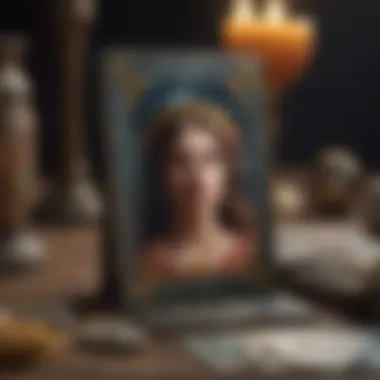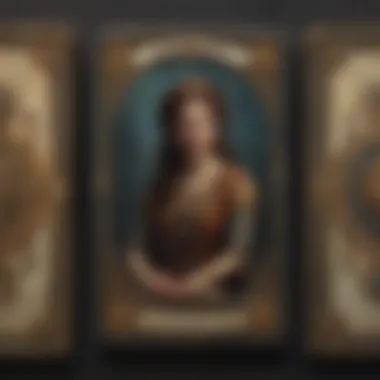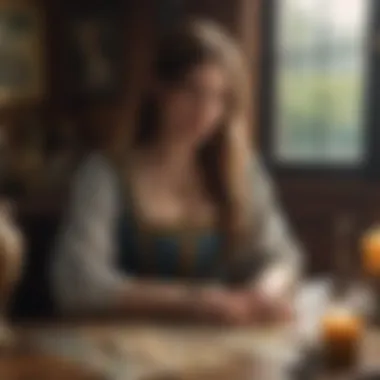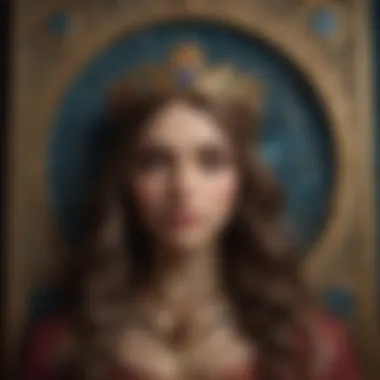An In-Depth Examination of Tarot Predictions and Insights


Intro
Tarot has been a subject of intrigue and contemplation for centuries. Many individuals approach it with curiosity, while others see it as a serious tool for introspection. In this exploration, we will analyze the intricacies surrounding tarot predictions, shedding light on their methodologies, historical evolution, and significant implications.
These insights are not just for the seasoned practitioners, but also for those new to this esoteric art. Understanding tarot is about more than just the cards themselves. It’s about grasping how these cards can offer personal insights, facilitate self-discovery, and guide decision-making processes through their rich symbolism and meanings.
Understanding the Zodiac
Overview of Zodiac Signs
The zodiac is divided into twelve distinct signs, each corresponding to specific personality traits and characteristics. Each sign, governed by a celestial body, plays a significant role in astrology, which often overlaps with tarot interpretations. Understanding your zodiac sign can provide a solid foundation for interpreting tarot readings, as both systems rely heavily on symbols and archetypes.
Sign Traits and Characteristics
Each zodiac sign embodies unique traits:
- Aries (March 21 - April 19): Energetic, adventurous, and assertive.
- Taurus (April 20 - May 20): Reliable, practical, and patient.
- Gemini (May 21 - June 20): Curious, adaptable, and communicative.
- Cancer (June 21 - July 22): Intuitive, emotional, and nurturing.
- Leo (July 23 - August 22): Confident, charismatic, and creative.
- Virgo (August 23 - September 22): Analytical, meticulous, and dedicated.
- Libra (September 23 - October 22): Diplomatic, charming, and sociable.
- Scorpio (October 23 - November 21): Passionate, resourceful, and determined.
- Sagittarius (November 22 - December 21): Open-minded, optimistic, and adventurous.
- Capricorn (December 22 - January 19): Disciplined, ambitious, and responsible.
- Aquarius (January 20 - February 18): Innovative, independent, and humanitarian.
- Pisces (February 19 - March 20): Compassionate, artistic, and introspective.
Elemental Qualities
The zodiac signs are also categorized by elemental qualities, which include:
- Fire: Aries, Leo, Sagittarius – associated with passion and enthusiasm.
- Earth: Taurus, Virgo, Capricorn – linked to stability and practicality.
- Air: Gemini, Libra, Aquarius – connected to intellect and communication.
- Water: Cancer, Scorpio, Pisces – related to emotions and intuition.
Recognizing these elemental qualities can enhance one’s approach to tarot readings. Certain cards may resonate differently based on the element they embody.
Astrological Insights
Current Astrological Trends
Astrological trends can be insightful, providing context to current tarot predictions. For example, planets entering specific signs may impact collective energies, influencing how tarot readings are interpreted during that period.
Influence of Celestial Events
Celestial events, such as eclipses or retrogrades, can hold profound implications in the tarot world. During these times, individuals may find deeper significance in their readings, prompting reflection and potential change in mindset or behavior.
How to Interpret Your Birth Chart
A birth chart offers a blueprint of celestial influences at the moment of one’s birth. Understanding this chart can significantly enhance tarot readings, as it provides personalized insights. Practitioners often consult their charts alongside tarot spreads for deeper revelations and insights guided by the stars.
Horoscope and Predictions
Monthly or Weekly Forecasts
Horoscopes provide general predictions based on zodiac signs, often aligning with tarot insights. Engaging with both can offer coherent narratives for individuals seeking direction and guidance.
Personalized Horoscope Reading
A tailored horoscope reading incorporates personal birth details, mirroring the individualized approach of tarot. It delves into personal strengths and areas for growth, complementing tarot's symbolic messages.
Compatibility Readings based on Zodiac Signs
Compatibility readings evaluate interpersonal dynamics between different zodiac signs. This aspect can intersect with tarot predictions, revealing how one's tarot energies align or clash with counterparts.
Exploring the intersection of tarot and astrology enriches both practice. Each discipline offers unique insights while enhancing understanding of the other.
Understanding Tarot Predictions
Understanding tarot predictions is a vital aspect of exploring tarot as both an art and a science. This section provides a foundation for a deep dive into the intricacies of tarot. Through this examination, readers will appreciate the role tarot plays in personal development, insight generation, and the larger context of spiritual inquiry.
Defining Tarot and Its Purpose
Tarot refers to a deck of cards traditionally used for divination. The purpose of tarot extends beyond mere fortune-telling; it serves as a tool for reflection, enabling individuals to access their subconscious thoughts and feelings. Tarot facilitates introspection, fostering a dialogue between the conscious and unconscious mind. Through meaningful symbols and archetypes, each card offers profound insights that can guide one's decision-making process. Understanding this foundational purpose prepares readers for effective engagement with the practice.


The Historical Context of Tarot
Tarot originated in the mid-15th century as a card game in Europe. Its evolution into a tool for divination began in the 18th century, influenced by various esoteric traditions. This historical trajectory reveals how tarot transitioned from a social pastime to a significant spiritual practice. Examining the evolution illustrates cultural shifts in belief systems and the growing interest in occult practices. This context enriches the understanding of tarot today.
The Structure of a Tarot Deck
A standard tarot deck consists of 78 cards divided into two main categories: Major Arcana and Minor Arcana. Each category has a distinct role in readings and offers unique insights.
Major Arcana Overview
The Major Arcana consists of 22 cards, each representing significant life themes and spiritual lessons. These cards often indicate profound influences and critical turning points in a person's life. Their key characteristic is the depth of meaning they convey, illuminating major changes or lessons the querent is likely to encounter. Choosing the Major Arcana for readings can yield substantial insights, as these cards usually deal with core aspects of existence. However, interpreting these cards effectively requires a substantial understanding of their unique symbolism and implications.
Minor Arcana Overview
The Minor Arcana comprises 56 cards, divided into four suits: Cups, Pentacles, Swords, and Wands. Each suit corresponds to different facets of daily life and human experience, such as emotions, material issues, challenges, and creativity. The key characteristic of the Minor Arcana is its focus on the rhythms of day-to-day experiences. While these cards may appear less momentous than the Major Arcana, their detailed nuances provide clarity in more everyday matters. Mastering the Minor Arcana allows for a comprehensive understanding of the subtleties within readings.
Suit Significance
Understanding suit significance is crucial for interpreting a tarot reading holistically. Each suit holds its own attributes and themes, enriching the overall narrative presented during a reading. The Cups deal primarily with relationships and emotions, the Pentacles with material wealth and stability, the Swords signify conflict and intellect, while the Wands represent creativity and passion. This categorization not only influences the narrative of the reading but also enhances the querent’s understanding of their circumstances. Grasping suit significance is essential to unraveling the intricate layers of meaning within tarot predictions.
The Process of Tarot Reading
The process of tarot reading can be seen as both an art and a science. It is a crucial component of working with tarot predictions. Understanding this process can enhance one’s ability to connect with the cards and derive meaningful insights. Tarot reading is not simply about interpreting symbols. It's about creating a dialogue between the reader and the cards, fostering a deeper understanding of the self and the universe.
Selecting a Spread
Choosing the right tarot spread is essential in guiding a reading. The spread determines the layout of the cards and influences the interpretation of their meanings. Each type of spread has distinct features that serve specific purposes.
Single Card Draw
The Single Card Draw is a straightforward but powerful method. It offers immediate insight into a question or situation. Its key characteristic is simplicity. This approach encourages focused thought, making it a beneficial choice for quick guidance. By drawing just one card, one can pinpoint energy or advice related to a specific issue.
However, the Single Card Draw has limitations. It may not provide the depth that more complex spreads offer. For instance, it gives a snapshot of a moment rather than a comprehensive view. Despite this, its immediacy and ease make it appealing, especially for beginners or as a daily check-in.
Three-Card Spread
The Three-Card Spread offers more nuance compared to the single card. This method allows readers to explore past, present, and future influences on a situation. The ability to draw connections between the three positions makes it a popular choice among practitioners.
Each card in this spread adds layers to the interpretation. The reader can easily evaluate how past experiences shape current situations and what potential outcomes could arise. However, it may require deeper analytical skills to piece these insights together effectively. Nonetheless, its balance of complexity and clarity makes it widely used.
Celtic Cross Spread
The Celtic Cross Spread is one of the most comprehensive tarot layouts. It consists of ten cards, providing insight into various facets of a situation. The key characteristic is its depth. The Celtic Cross not only covers immediate influences but also looks at obstacles, advice, and potential outcomes, making it an excellent choice for detailed readings.
However, the complexity of this spread can be overwhelming for new readers. Understanding how each card interacts with the others demands a higher level of intuition and familiarity with tarot meanings. For experienced users, the Celtic Cross reveals multiple dimensions of a query, thus offering a rich reading experience.
Interpreting the Cards
Interpreting tarot cards is where the real magic happens. This phase moves beyond just reading card meanings. It involves understanding various nuances that affect their interpretations.
Reversed vs Upright Cards
Reversed vs Upright Cards is an important distinction in tarot interpretations. An upright card typically signifies positive energies, while reversed cards can indicate blocks or challenges. The key characteristic here lies in the layers of meaning.
Understanding the differences is invaluable for a comprehensive reading. Using both positions adds depth to interpretations, helping to navigate complex situations. However, some readers avoid reversed cards due to the potential for misinterpretation. Embracing both options can enhance a reading’s richness and provide a balanced perspective.
Contextual Meanings
Contextual Meanings delves into how the environment, question, and reader's intuition influence card interpretations. This approach recognizes the importance of circumstances surrounding the reading.
The uniqueness of contextual meanings lies in their adaptability. Each card can convey multiple messages depending on the situation. This flexibility makes it essential for meaningful readings. However, it requires intuition and experience to navigate these nuances effectively. Balancing context with traditional interpretations enriches the overall insight.
Intuitive Insights


Intuitive Insights bring a personal touch to tarot reading. After studying the cards, many readers rely on their intuition to interpret the meanings. This aspect can be quite powerful, as it reflects the reader's inner wisdom.
The key feature of intuitive insights is their subjectivity. Each reader brings a unique perspective, which can shape card interpretations. This subjective quality can be both an advantage and a disadvantage. While it can lead to highly personalized readings, it may also introduce biases. Nevertheless, trusting one’s intuition can transform a routine reading into a profoundly relevant experience.
Creating a Connective Atmosphere
The atmosphere in which a tarot reading takes place is crucial. It sets the tone for connection and focus. A well-prepared environment can enhance both the reader's and the querent's experience.
Establishing a peaceful space free from distractions is important. This enables clear communication with the cards and fosters a deeper mindset for all participants. Other factors such as lighting, scents, and even background music can influence the atmosphere.
Specific Applications of Tarot Predictions
The exploration of tarot predictions extends beyond mere curiosity; it taps into significant life themes. This section delves into three core applications: personal growth and self-discovery, relationship insights and compatibility, along with career and financial predictions. Each of these areas presents distinct benefits and provoke thoughtful consideration on how tarot can influence various life aspects.
Personal Growth and Self-Discovery
Tarot acts as a powerful tool for introspection. It encourages individuals to reflect on their current situation and to confront their inner thoughts and feelings. Through card readings, themes of self-awareness emerge, allowing for meaningful personal insights. Each card tells a story, prompting questions that lead to deeper self-examination.
Particular spreads, such as the Single Card Draw, can focus on a specific query. This simplicity fosters clarity. By engaging regularly with tarot, people may develop a greater understanding of their motivations and desires. This self-discovery journey nurtures emotional intelligence, which is essential for personal growth.
- Key Elements:
- Reflection
- Self-awareness
- Emotional intelligence
Relationship Insights and Compatibility
As relationships are complex, tarot can highlight areas for exploration and growth. Utilizing specific spreads like the Celtic Cross can provide insights into relationship dynamics, compatibility, and potential challenges. The cards can shed light on underlying issues that may not be readily apparent. This perspective can facilitate healthier communication and partnership choices.
For example, when exploring compatibility, the connections between key cards can reveal much about interpersonal dynamics. The symbolism in each card reflects desires, challenges, and energies that influence relationships.
- Key Elements:
- Relationship dynamics
- Communication
- Symbolism in cards
Career and Financial Predictions
Tarot can offer guidance on career paths and financial decisions. Certain cards may suggest opportunities or obstacles in the professional realm. By focusing on career-specific spreads, individuals can gain clarity regarding their aspirations and potential career moves. Understanding the implications of specific cards allows for informed decision-making.
Financial aspects can also benefit from tarot insights. The cards can illuminate spending habits and investment choices. This perspective can lead to more responsible financial behaviors and a clear understanding of one’s financial landscape. Furthermore, considering intuitive insights can enhance strategic planning in one's career journey.
- Key Elements:
- Career guidance
- Strategic decision-making
- Financial awareness
The Psychological Dimension of Tarot
The realm of tarot extends beyond mere card reading; it encompasses a significant psychological component that influences how individuals perceive their lives and make decisions. Understanding the psychological dimension of tarot is crucial as it highlights the interconnection between tarot practice and human cognition, emotional well-being, and mindfulness. This section delves into the cognitive frameworks that underpin tarot reading, the effects on decision-making processes, and how tarot serves as an effective tool for mindfulness.
Cognitive Frameworks in Tarot Reading
Cognitive frameworks refer to the mental structures that help individuals organize and interpret information. In the context of tarot reading, these frameworks play an important role. When a seeker consults the tarot, they engage a variety of cognitive processes. For instance, the symbolism inherent in each card allows the reader to stimulate reflection and interpret life experiences. Familiarity with card meanings and their relationships forms a foundation that aids in categorizing thoughts and emotions.
When a tarot reader interprets a spread, they rely on established frameworks to draw connections between cards. This associative thinking enhances both the reading process and the seeker’s understanding of their circumstances. Moreover, personal experiences and beliefs interplay with the cognitive structures employed in tarot reading, leading to rich and nuanced interpretations.
Effects on Decision-Making Processes
The role of tarot in decision-making is both intriguing and complex. Tarot cards can influence how people approach their choices. When faced with uncertainty, individuals may turn to tarot as a means of gaining clarity. By presenting symbolic narratives, tarot can illuminate potential paths and outcomes. This can reduce anxiety and foster a sense of agency.
Moreover, tarot readings can act as a catalyst for self-reflection. When seekers confront their innermost thoughts, they often discover subconscious barriers and motivations. This understanding can shift their decision-making process. In some cases, the tarot may encourage individuals to consider choices they had previously overlooked. The act of laying out cards and interpreting them engages cognitive functions that can lead to more informed decisions.
Tarot as a Tool for Mindfulness
Mindfulness is a state of awareness and presence, often achieved through reflective practices. Tarot reading facilitates mindfulness through its structured approach. The process of engaging with tarot requires one to pause and reflect, allowing thoughts and feelings to surface. This meditative aspect enhances focus and self-awareness, making tarot an effective tool for mindfulness.


During a reading, seekers often become absorbed in the moment, stripping away distractions. Each card drawn acts as a focus point for contemplation. This can support emotional regulation and foster a deeper understanding of one's feelings and thoughts.
Tarot serves as both a mirror and a lens, revealing hidden aspects of oneself while framing current experiences in a new light.
Using tarot as a mindfulness tool can lead to personal growth. Regular practice encourages individuals to explore their emotions and thoughts, enhancing their overall mental health. In achieving a deeper state of awareness, seekers not only gain insights but also cultivate a more balanced approach to life's challenges.
The Limitations of Tarot Predictions
Tarot predictions, while insightful and often transformative, come with inherent limitations. Understanding these restrictions is crucial for both practitioners and clients. They can shape expectations and guide users in a responsible way. A grounded approach to tarot serves to enhance its effectiveness as a tool for introspection. Misinterpretation or excessive reliance on tarot may lead to confusion or disillusionment. This section will explore significant aspects surrounding the limitations of tarot predictions.
Understanding the Boundaries
In the realm of tarot, boundaries play an essential role. Each reading should be seen as a guide rather than an absolute verdict. Here are several boundaries to consider:
- Subjectivity: Perceptions can vary widely among individuals. Different readers may interpret the same cards in distinct manners based on their knowledge and intuition.
- Temporal Nature: Tarot readings reflect a moment in time. Situations evolve, and events may unfold differently than predicted. It's vital to remember that these predictions are not set in stone.
- Personal Agency: The act of making choices need not rely solely on tarot. Individuals maintain the power to change their paths regardless of what the cards indicate.
A clear awareness of these boundaries helps foster a healthy relationship with tarot. Engaging with the cards should inspire self-reflection and growth. Still, it should not replace personal decision-making or external guidance.
Ethical Considerations in Tarot Reading
Ethics in tarot reading is an area that deserves attention. Practitioners should be aware of their responsibilities when conducting readings. Think about the following ethical elements:
- Informed Consent: Clients must understand the nature of tarot readings. Being transparent about what to expect aids in setting realistic goals.
- Sensitivity: Readers must exercise care when discussing potentially sensitive topics. Emotional impacts can linger, resulting in lasting effects on individuals.
- Accountability: Practitioners should approach readings with professionalism. Providing responsible interpretations can safeguard against unethical practices.
A conscientious reader acts not just as a guide, but as a support system for the client, recognizing the weight that predictions can carry.
In summary, being mindful of limitations and ethical considerations is vital in tarot practice. Knowing where tarot's boundaries lie preserves its role as a tool for personal and spiritual development.
Modern Perspectives on Tarot Predictions
In recent times, tarot predictions have found new relevance and vitality in contemporary society. The modern perspective on tarot emphasizes its adaptability and accessibility, allowing it to remain an integral part of many individuals’ spiritual and self-discovery journeys. This perspective explores how tarot serves not only as a tool for personal insight but also reflects broader societal changes, including the rise of technology and evolving beliefs about spirituality.
The Rise of Digital Tarot Platforms
The digital age has ushered in a transformative wave for tarot practice. Online platforms and mobile applications have democratized tarot readings, making them accessible to a wider audience. These digital platforms offer users the ability to engage with tarot through various means:
- Virtual Readings: Users can connect with professional readers from around the world via video calls or chat services. This accessibility has broadened the market and allowed diverse perspectives in tarot interpretations.
- Card Interpretations: Many apps provide extensive databases of card meanings, allowing users to conduct their own readings and deepen their understanding of the cards. This feature facilitates self-exploration and personal insights, empowering individuals to engage with tarot more independently.
- Community Engagement: Platforms like Reddit and Facebook integrate community features where enthusiasts can discuss interpretations, share experiences, and seek advice. This fosters a sense of belonging and a support system among those exploring tarot.
The rise of digital tarot highlights a shift in how individuals interact with tarot as a practice. It offers both convenience and a sense of connection in a globalized world.
Integration of Tarot in Popular Culture
The presence of tarot in popular culture has noticeably expanded. Movies, television shows, and literature have increasingly included references to tarot, reflecting its allure and mystical quality.
- Media Representation: Many films and series incorporate tarot readings as a narrative device, enhancing character development or adding depth to plotlines. These portrayals can create intrigue about tarot and encourage audiences to explore it personally.
- Fashion and Aesthetics: Tarot imagery has found its way into fashion, art, and product designs, which adds a cultural cachet to the symbolism in tarot. Tarot cards serve not only as tools for divination but also as artistic expressions that resonate with a modern audience.
- Psychological Exploration: As more people engage with tarot, it intertwines with discussions about mental health and wellness. Many view tarot as a means to self-reflection and mindfulness, further embedding its relevance in contemporary discourse on psychological well-being.
The End and Future Considerations
In this final section, we will focus on the significance of tarot predictions and their ongoing relevance in contemporary discourse. Tarot serves not only as a tool for individual insights but also as a reflection of broader societal trends. Its adaptability speaks volumes about its purpose and potential in guiding personal and collective growth.
Reflections on Tarot's Relevance
Tarot has a unique place in the fabric of modern spirituality. Its historical roots and ongoing evolution highlight the capacity for adaptation and transformation. The language of tarot captures the essence of human experience, bridging the gaps between intuition and rational thought. In an age dominated by data and analytics, tarot offers an alternative lens through which to view challenges, providing meaning amidst confusion.
The resurgence of interest in tarot can be attributed to several factors:
- Increased interest in spirituality: Many people seek deeper meanings in their lives away from conventional religious frameworks.
- Crisis of identity: In turbulent times, individuals often turn to introspection, seeking systems that facilitate self-understanding.
- Community and connection: Tarot gatherings and online forums foster a sense of belonging among practitioners.
Tarot’s relevance is firmly grounded in its ability to provide insights relevant to the complexities of life. This goes beyond mere fortune-telling; it encourages critical thought and reflection.
Potential for Personal and Societal Growth
The implications of tarot prediction extend into the realms of personal and societal levels. At the personal level, tarot can guide individuals toward increased self-awareness and emotional intelligence. The act of reading tarot cards emphasizes the importance of understanding one's emotions and motivations. Each card draws attention to different facets of life, encouraging holistic contemplation of various aspects.
On a societal scale, tarot readings can foster dialogue and openness towards exploring different viewpoints.
- Holistic healing: Tarot can be integrated with other therapeutic practices, promoting mental wellbeing.
- Cultural appreciation: Practicing tarot encourages awareness and understanding of diverse traditions.
- Societal awareness: Insights gained from readings can influence community actions and collective consciousness.
The future of tarot lies in its innovative application in personal growth, mental health practices, and community development. As practitioners continue to explore its depths, tarot's role will evolve further, enriching both individual lives and societal narratives.
In summary, tarot is not just a relic of the past; it is a living tradition that can illuminate paths toward sustainable growth and understanding in a rapidly changing world.







